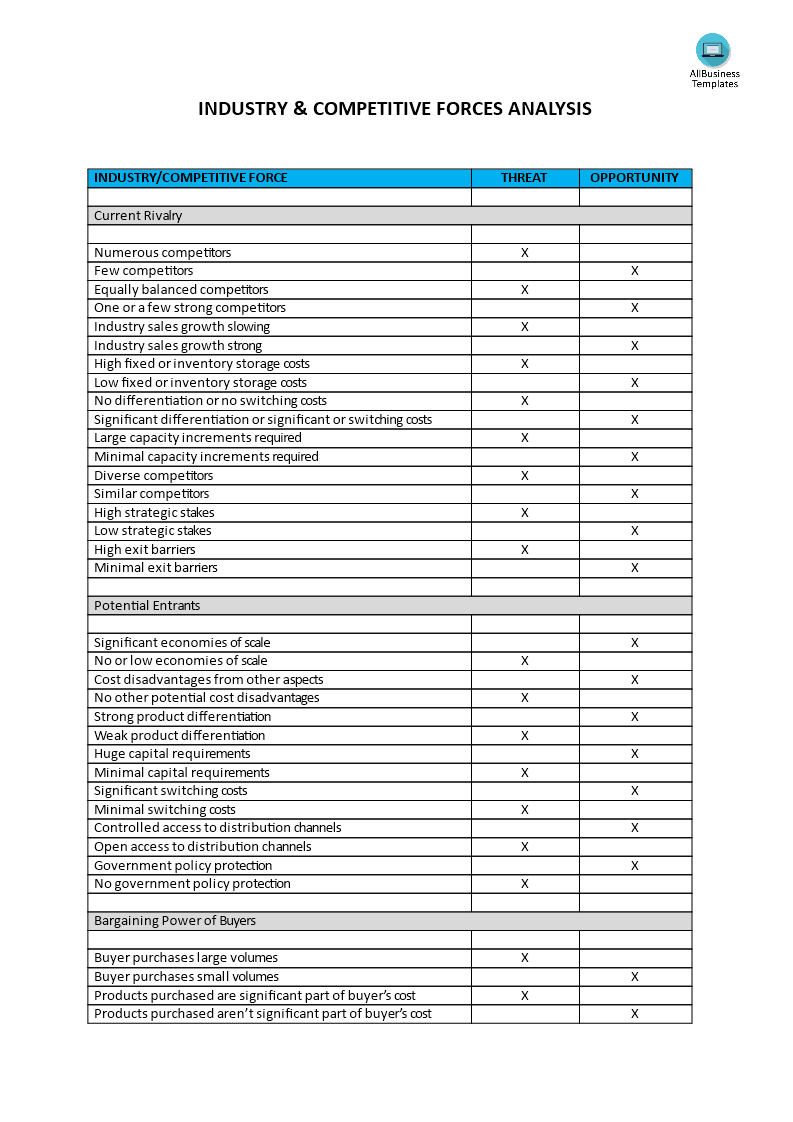Industry & Competitive Forces Analysis Worksheet
Save, fill-In The Blanks, Print, Done!

Download Industry & Competitive Forces Analysis Worksheet
Today: USD 1.99
Download It Now

Available premium file formats:
Microsoft Word (.docx)- This Document Has Been Certified by a Professional
- 100% customizable
- This is a digital download (25.75 kB)
- Language: English
- You will receive a link to download the file as soon as your payment goes through.
- We recommend downloading this file onto your computer.
Do you need a worksheet on industry & competitive forces analysis? Looking for a template for an industry & competitive forces analysis worksheet? Our template is easy to use and will help you to analyze and understand the competitive landscape of an industry. It also provides a concise overview of the key forces that might affect the industry's growth, profitability, and competition. Download this sample template now!
An "Industry & Competitive Forces Analysis Worksheet" is a tool used in strategic planning and business analysis to assess and evaluate the competitive environment of a specific industry or market. It helps businesses and organizations gain insights into the competitive dynamics, opportunities, and threats within their industry. This analysis is often conducted using frameworks like Michael Porter's Five Forces model.
Here are the key components typically found in an Industry & Competitive Forces Analysis Worksheet:
- Industry Overview: Provide a brief overview of the industry or market being analyzed, including its size, growth rate, and key characteristics.
- Competitive Forces Analysis:
- Threat of New Entrants: Assess the barriers to entry in the industry, such as capital requirements, economies of scale, regulatory restrictions, and brand loyalty. Determine the ease with which new competitors can enter the market.
- Bargaining Power of Suppliers: Evaluate the power suppliers have over firms in the industry. Consider factors like the number of suppliers, the uniqueness of their products, and the importance of their inputs to your industry.
- Bargaining Power of Buyers: Assess the power buyers have to negotiate prices and terms. Consider factors like the number of buyers, their size, and their ability to switch to alternative products or suppliers.
- Threat of Substitute Products or Services: Identify potential substitutes for your industry's products or services. Determine how easily customers can switch to these substitutes and whether they offer comparable value.
- Intensity of Competitive Rivalry: Analyze the competitive rivalry within the industry. Consider factors such as the number and diversity of competitors, market concentration, pricing pressure, and the pace of innovation.
- Key Competitors: List the major competitors in the industry and provide a brief description of each, including their market share, strengths, weaknesses, and strategic focus.
- Competitive Advantage: Identify your organization's competitive advantages or unique selling points. This could include factors like technology, brand recognition, cost leadership, or product differentiation.
- Opportunities and Threats: Summarize the key opportunities and threats identified through the analysis. Opportunities may arise from weak competitive forces, while threats may emerge from strong competitive forces or changes in the industry.
- Strategic Implications: Discuss the strategic implications of the analysis. What strategies can your organization pursue to leverage opportunities or mitigate threats? Consider areas such as product development, pricing, marketing, partnerships, and market expansion.
- Action Plan: Outline the specific actions or initiatives that your organization plans to undertake based on the analysis. Assign responsibilities and set timelines for implementation.
- Monitoring and Review: Specify how and when the organization will monitor the industry and competitive forces to ensure that the strategic plan remains relevant and effective.
- References and Data Sources: Include references to data sources, research reports, or external information used to conduct the analysis.
The Industry & Competitive Forces Analysis Worksheet serves as a structured framework for businesses to systematically evaluate the competitive landscape and make informed strategic decisions. It is a valuable tool for understanding market dynamics, formulating competitive strategies, and maintaining a competitive edge in the industry.
Download this professional Worksheet Industry & Competitive Forces Analysis template now!
DISCLAIMER
Nothing on this site shall be considered legal advice and no attorney-client relationship is established.
Leave a Reply. If you have any questions or remarks, feel free to post them below.
Related templates
Latest templates
Latest topics
- Excel Templates
Where do I find templates for Excel? How do I create a template in Excel? Check these editable and printable Excel Templates and download them directly! - GDPR Compliance Templates
What do you need to become GDPR compliant? Are you looking for useful GDPR document templates to make you compliant? All these compliance documents will be available to download instantly... - Google Docs Templates
How to create documents in Google Docs? We provide Google Docs compatible template and these are the reasons why it's useful to work with Google Docs... - IT Security Standards Kit
What are IT Security Standards? Check out our collection of this newly updated IT Security Kit Standard templates, including policies, controls, processes, checklists, procedures and other documents. - Letter Format
How to format a letter? Here is a brief overview of common letter formats and templates in USA and UK and get inspirited immediately!
cheese
